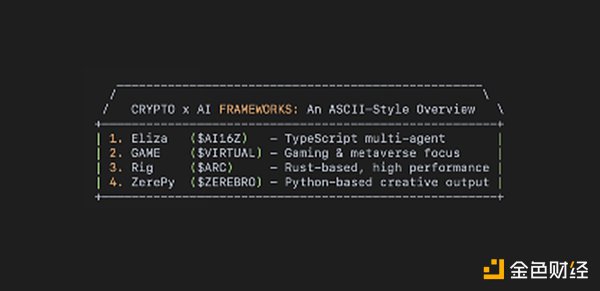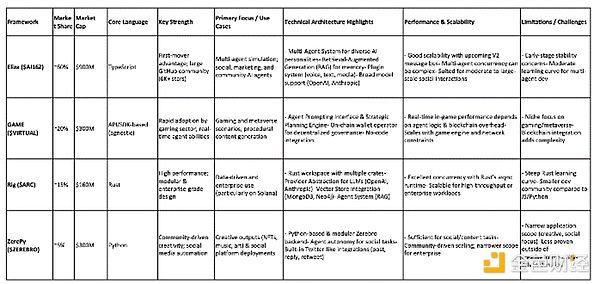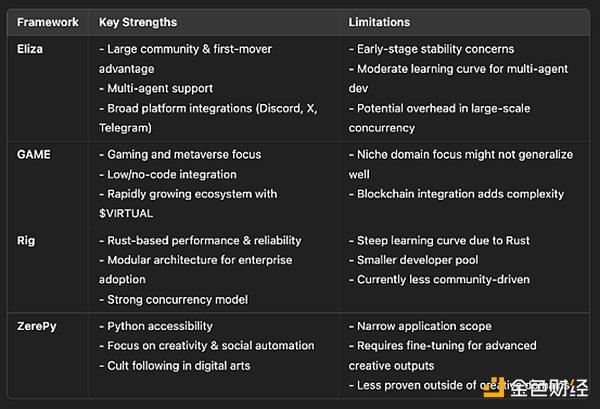Author: Arndxt, Threading on the Edge; Translator: Jinse Finance xiaozou
The main frameworks in the Crypto x AI field are: Eliza (AI16Z), GAME (VIRTUAL), Rig (ARC) and ZerePy (ZEREBRO).

These four frameworks can meet different development needs.
Driven by the first-mover advantage and the thriving TypeScript community, Eliza dominates the market with about 60% market share, while GAME (about 20% market share) aims to be rapidly adopted in gaming and virtual world applications.
Rig (about 15% market share) is developed using Rust, providing performance-oriented modular performance suitable for the Solana ecosystem, while the new Python-based architecture ZerePy (about 5% market share) focuses on creative output and social media automation. The total market value of these frameworks is $1.7 billion, and as the application of AI and crypto expands, their total market value may exceed $20 billion, making the market-weighted approach potentially attractive. Each framework occupies a unique market - social and multi-agent (Eliza), gaming/virtual worlds (GAME), enterprise performance (Rig) and creative community use (ZerePy) - providing complementary choices rather than direct competition.
1. Overview and Market Positioning of the Four Frameworks

(1) Eliza ($AI16Z)
● Market Share: ~60%
● Market Cap: $900 million
● Core Language: TypeScript
● Key Advantages: First-mover advantage, large GitHub community (over 6,000 stars, 1,800 forks)
● Focus: Multi-agent simulation, cross-platform social engagement
As one of the earliest AI agent frameworks in the field, Eliza has taken a dominant position. Its first-mover advantage is supported by a large contributor community, which has accelerated development and driven user adoption. Eliza's TypeScript stack makes it very suitable for web-based ecosystem developers, ensuring broad appeal.
(2) GAME (VIRTUAL)
● Market Share: ~20%
● Market Cap: $300 million
● Core Language: (API/SDK-based; language-agnostic approach)
● Key Advantages: Rapid adoption in the gaming industry, real-time agent capabilities.
● Focus: Procedural content generation, adaptive NPC behavior.
GAME is custom-built for gaming and virtual world applications. Its API-driven architecture and tight integration with the VIRTUAL ecosystem have generated tremendous momentum: it has over 200 projects, 150,000 requests per day, and rapid weekly growth. GAME's no-code integration further attracts teams prioritizing rapid deployment over deep technical customization.
(3) Rig (ARC)
● Market Share: ~15%
● Market Cap: $160 million
● Core Language: Rust
● Key Advantages: Performance, modular design (enterprise-grade)
● Focus: Solana-based "pure-play games", emphasizing retrieval-augmented generation.
Rig, built on a Rust architecture, caters to developers who value speed, memory safety, and efficient concurrency. It is designed for "enterprise-grade" or data-intensive applications, particularly suited for Solana-based applications. Although the learning curve is steeper, Rig offers modular performance and reliability to attract systems-oriented developers.
(4) ZerePy (ZEREBRO)
● Market Share: ~5%
● Market Cap: $300 million
● Core Language: Python
● Key Advantages: Community-driven creativity, social media automation.
● Focus: Agent deployment on social platforms, particularly for artistic or niche outputs.
ZerePy is a latecomer, originating from Zerebro's core backend. Its Python foundation, combined with a focus on creative applications (NFTs, music, and digital art), has attracted a passionate following. Collaboration with Eliza has increased ZerePy's visibility, but its narrower focus may limit widespread enterprise adoption.
2. Technical Architecture and Core Components
(1) Eliza (AI16Z)
● Multi-Agent System: Deploy multiple AI personalities under a shared runtime.
● Memory Management (RAG): Retrieval-augmented generation pipeline for long-term context.
● Plugin System: Supports community-developed extensions for modalities like speech, text, media parsing (e.g., PDF, images).
● Broad Model Support: Integrates local open-source LLMs or cloud APIs (OpenAI, Anthropic).
Eliza's technical design centers around multi-modal communication, making it well-suited for social, marketing, or community-based AI agents. While it excels at easy integrations (Discord, X, Telegram), large-scale use requires careful orchestration of different agent personalities and memory modules.
(2) GAME (VIRTUAL)
● API + SDK Model: Simplifies agent integration for game companies and virtual world projects.
● Agent Prompt Interface: Coordinates user input and agent strategy engine interactions.
● Strategy Planning Engine: Breaks down agent logic into high-level goal planning and low-level strategy execution.
● Blockchain Integration: Potential on-chain wallet operators for decentralized agent governance.
GAME's architecture is highly customized for game or virtual environment use cases, prioritizing real-time performance and continuous agent adaptation. While its scope is not limited to gaming, the system's design is clearly oriented towards virtual worlds and procedural generation scenarios.
(3) Rig (ARC)
● Rust Workspace Structure: Separates functionality into multiple crates to ensure clarity and modularity.
● Provider Abstraction Layer: Standardizes interactions with various LLM providers (OpenAI, Anthropic).
● Vector Store Integration: Supports multiple backends (MongoDB, Neo4j) for context retrieval.
● Agent System: Embeds retrieval-augmented generation (RAG) and specialized tool usage.
Rig's high-performance design benefits from Rust's concurrency model, making it an ideal choice for enterprise environments requiring strict resource management. Its conceptual clarity, through layered abstractions, provides robust reliability, but Rust's learning curve may limit the developer pool.
(4) ZerePy (ZEREBRO)
● Python-based Development: Accessible to AI/ML developers familiar with Python codebases and workflows.
● Modular Zerebro Backend: Provides creative content generation, particularly for social media and art.
● Agent Autonomy: Focuses on "creative output" tasks like meme, music, and NFT generation.
● Social Platform Integration: Includes built-in commands (post, reply, retweet) similar to Twitter functionality.
ZerePy fills a gap for Python developers seeking to deploy agents directly on social platforms. While ZerePy's scope is narrower than Eliza or Rig, its art or entertainment-driven use cases are thriving, especially in decentralized communities.
3. Comparison Dimensions of the Four Frameworks
(1) Usability
● Eliza: Adopts a balanced approach, with a moderate learning curve due to the complexity of multi-agent, but has a strong TypeScript developer base.
● GAME: Designed for non-technical adopters in the gaming domain, providing no-code or low-code approaches.
● Rig: More challenging; Rust language requires specialized expertise, but delivers high performance and reliability.
● ZerePy: Simplest for Python users, especially in creative or media-focused AI tasks.
(2) Scalability
● Eliza: The V2 iteration introduced a scalable message bus, improved concurrency, but multi-agent concurrency may be complex.
● GAME: Scalability is related to the demands of real-time gaming and blockchain networks; if the game engine constraints are controlled, performance will remain stable.
● Rig: Naturally has scalability through Rust's asynchronous runtime, suitable for high-throughput or enterprise-level workloads.
● ZerePy: Scalability is community-driven, mainly tested in creative or social media environments, with less emphasis on large enterprise loads.
(3) Adaptability
● Eliza: Has the highest adaptability for the plugin system, with broad model support and cross-platform integration.
● GAME: Specifically adapted to the gaming environment, can be integrated into various game engines, but not very suitable for areas outside the gaming domain.
● Rig: Suitable for data-intensive tasks or enterprise tasks; provides a flexible vendor layer for multi-LLM and vector storage.
● ZerePy: Oriented towards creative output; easily extensible within the Python ecosystem, but with a relatively narrow domain.
(4) Performance
● Eliza: Optimized for fast-paced social media or conversational tasks, its performance depends on external model API.
● GAME: Real-time performance of game dynamics; its success depends on the interplay between agent logic and blockchain overhead.
● Rig: Has high performance due to Rust's concurrency and memory safety, very suitable for complex large-scale AI processes.
● ZerePy: Performance depends on Python's speed and model calls; usually sufficient for social/content tasks, but not for enterprise-level throughput.
4. Strengths and Limitations

5. Market Potential and Prospects
These four frameworks have a combined market capitalization of $1.7 billion, and if the AI x Crypto industry follows the explosive growth pattern previously seen in L1 blockchains, they could potentially grow to over $20 billion. For investors who believe these frameworks (each serving a different market niche) will rise together under a broader "rising tide", a market cap-weighted approach may be the most prudent.
● Eliza (AI16Z): Due to its existing ecosystem, strong codebase, and upcoming enhanced V2 (e.g., Coinbase agent suite integration, TEE support), it may continue to maintain the highest market share.
● GAME (VIRTUAL): Likely to see further adoption in the gaming/metaverse space. The synergy with the VIRTUAL ecosystem ensures ongoing developer interest.
● Rig (ARC): May become the "hidden gem" for enterprise AI on Solana; as its partnership plans mature, it can replicate the traction enjoyed by other chain-specific frameworks.
● ZerePy (ZEREBRO): Although its scope is limited, it benefits from strong community development momentum and the Python ecosystem, particularly catering to creative and artistic use cases that are often overlooked by more generalized solutions.
6. Comparative Summary
(1) Technology Stack and Learning Curve
● Eliza (TypeScript) strikes a balance between accessibility and feature richness.
● GAME provides a accessible API for gaming, but may cater to a niche audience.
● Rig (Rust) maximizes performance at the cost of a higher complexity threshold.
● ZerePy (Python) is simple for creative applications, but lacks broader enterprise adoption.
(2) Community and Ecosystem
● Eliza: Performs best on GitHub, reflecting strong community engagement and wide applicability.
● GAME: Benefiting from VIRTUAL's support, experiencing rapid growth in the gaming and metaverse domain.
● Rig: Targeted at a technically savvy, small-scale developer community, focused on high-performance use cases.
● ZerePy: Growing niche community built around creative and decentralized art, its development benefits from the partnership with Eliza.
(3) Future Growth Catalysts
● Eliza: New plugin registry and TEE integration may further consolidate its leadership position.
● GAME: Aggressive expansion through the VIRTUAL ecosystem; accessible to non-technical users.
● Rig: Once developer traction increases, it may partner with Solana, and its enterprise focus could drive strong growth.
● ZerePy: Leveraging Python's popularity in the AI field, and the cultural momentum around creative, community-driven projects.








